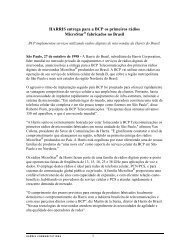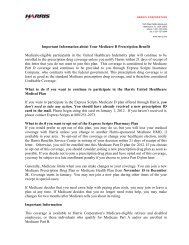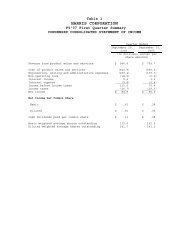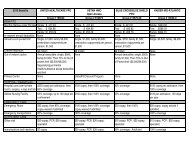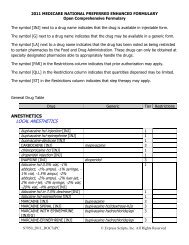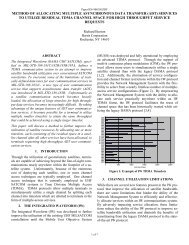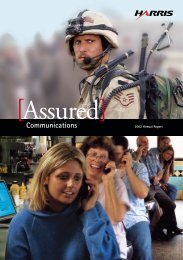OVERCOMING STRESSED SATELLITE NETWORKS USING ...
OVERCOMING STRESSED SATELLITE NETWORKS USING ...
OVERCOMING STRESSED SATELLITE NETWORKS USING ...
You also want an ePaper? Increase the reach of your titles
YUMPU automatically turns print PDFs into web optimized ePapers that Google loves.
to application specific requirements. The HNW<br />
currently uses either OLSR or OSPFv3 with directional<br />
routing to meet net-centric requirements in a mobile ad<br />
hoc environment.<br />
For example, the popular OLSR has been compared to<br />
AODV and Ad hoc On-demand Multipath Distance<br />
Vector (AOMDV) in maritime environments<br />
demonstrating the varied nature of net-centric systems<br />
[13]. The various payload lengths couple with the<br />
protocol overhead and affect the initial packet delay as<br />
well as packet delivery ratio. For the sea states and<br />
number of nodes presented in [13] AODMV provided<br />
better efficiencies than did OLSR. AODMV also<br />
provides multiple paths during the discovery process and<br />
would fit well with the alternate routing principles<br />
previously described in this paper.<br />
CONCLUSIONS AND FUTURE DIRECTIONS<br />
This paper has shown that while recent events in satellite<br />
jamming and disruption raise concerns, methods and<br />
equipment exist today to work around or through the<br />
stressed conditions. AJ signal processing techniques can<br />
be used in satellite terminals and Network Radios to<br />
mitigate jamming threats while preserving network<br />
connectivity and availability.<br />
Further, Network Radios and IP based Networks have<br />
inherent capabilities to mitigate jamming threats. Future<br />
efforts should be considered for further waveform<br />
enhancements including greater protection levels,<br />
dynamic routing and cognitive radio processing.<br />
Various protocols and protocol adaptations must be<br />
considered and their applications appropriately applied<br />
to the alternate network paths for maximum efficiency.<br />
Finally, the airborne and surface tiers should examine<br />
alternate modulation and coding formats enabling yet<br />
higher data rates and additional alternate paths. These<br />
studies should consider working across the physical and<br />
higher OSI layers to determine the best overall network<br />
performance. These areas of study should further these<br />
multiple layer considerations as begun by Bernhardt, et.<br />
al. [14]<br />
REFERENCES<br />
[1] R. L. Peterson, R. E. Ziemer and D. E. Borth,<br />
Introduction to Spread Spectrum Communications,<br />
Englewood Cliffs, NJ: Prentice Hall, 1995, pp. 321-326.<br />
[2] A. J. Viterbi and I. M. Jacobs, "Advances in coding<br />
and modulation for noncoherent channels affected by<br />
fading, partial-band and multiple-access interference," in<br />
Advances in Communication Systems, Vol. 4. New<br />
York: Academic, 1975.<br />
6 of 6<br />
[3] P. J. Crepeau, “A connection between Rayleigh<br />
fading and worst-case partial band interference,”<br />
MILCOM Proc. 1989, vol. 3, pp. 693-696.<br />
[4] Jhong S. Lee, and Leonard E. Miller, “Error<br />
Performance Analyses of Differential Phase Shift-<br />
Keyed/Frequency-Hopping Spread-Spectrum<br />
Communication System in the Partial-Band Jamming<br />
Environments,” IEEE Trans. on Comm., May 1982, pp.<br />
943-952.<br />
[5] Irfan Kosa, “Performance of IEEE 802.11a Wireless<br />
LAN Standard over Frequency-Selective, Slowly Fading<br />
Nakagami Channels in a Pulsed Jamming Environment,”<br />
Thesis, Naval Postgraduate School, Monterey, CA, Dec<br />
2002, Ch. 4 and 5.<br />
[6] Harris GCSD Networking Brochure, High-Capacity<br />
Wireless Networking, 2007.<br />
http://download.harris.com/app/public_download.asp?fi<br />
d=1759<br />
[7] Harris Highband Networking Radio Overview,<br />
“HNR - High Band Networking Radio Overview”, 2007.<br />
http://download.harris.com/app/public_download.asp?fi<br />
d=1321<br />
[8] Farooq Khan, “VoIP Models for 802.20 System<br />
Performance Evaluation,” IEEE 802.20 Interim Meeting<br />
Vancouver, BC, Canada, January 12-16, 2004.<br />
http://www.ieee802.org/20/Contribs/C802.20-04-<br />
12.ppt#271,2,VoIP Models for 802.20 System<br />
Performance Evaluation<br />
[9] Harris GCSD Satellite terminal Brochure, OM-<br />
88(V)1/G AS Modem System, 2008.<br />
http://download.harris.com/app/public_download.asp?fi<br />
d=1964<br />
[10] ITU-T Recommendation G.114, Series g:<br />
Transmission Systems and Media, Digital Systems and<br />
Networks, One-way Transmission Time, May 2003.<br />
[11] J. Broch, D.A. Maltz, D> B. Johnson, Y-C Hu and<br />
Jorjeta Jetcheva, “A Performance Comparison of Multi-<br />
Hop Wireless Ad Hoc Network Routing Protocols”,<br />
MONICOM 98, Dallas, TX, pp. 85-97.<br />
[12] J. Hsu, S. Bhatia, M. Takai, R. Bagrodia and M.<br />
Acriche, “Performance of Mobile Ad Hoc Networking<br />
Routing Protocols in Realistic Scenarios”, MILCOM<br />
2003, IEEE, vol. 2, pp. 1268 – 1273.<br />
[13] P-Y Kong, H. Wang, Yu Ge, C-W Ang, S. Wen,<br />
J.S. Pathmasuntharam, M-T Zhou, H. V. Dien, “A<br />
Performance Comparison of Routing Protocols for<br />
Maritime Wireless Mesh Networks”, WCNC 2008,<br />
IEEE, pp. 2170–2175.<br />
[14] R. Bernhardt, J. B. Cain and W. Windham, “QOS<br />
Architecture for a Mobile Ad Hoc Network”, MILCOM<br />
2007.




